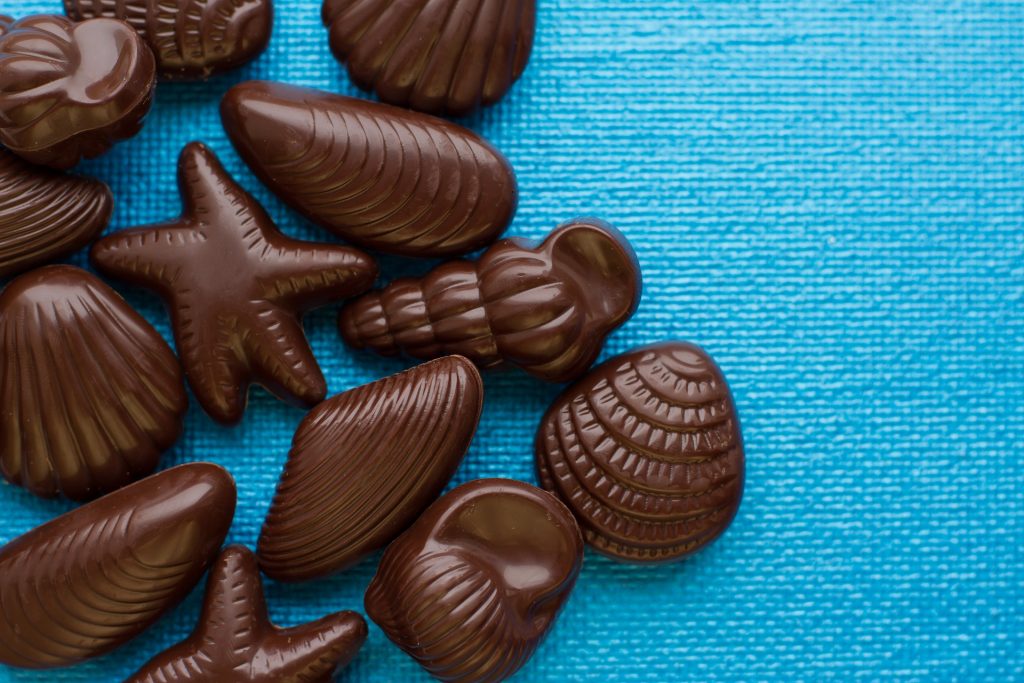[Article updated on 19/09/2023]
The candy chosen by dad in a tobacco shop, the one bought by grandma at the supermarket checkout, the ones we received in boxes at friends’ birthdays…
Candy reminds everyone of specific memories.
And if these little sweets, sometimes tangy, sometimes spicy, chocolatey or fruity, make us smile, they are not all healthy!
We still consume 6.8 kilos per second in France, or 214,500 tonnes per year! There are still more than 20 varieties and more than 600 regional specialties.
Candy is essentially sugar! Sometimes, depending on the type of candy, ingredients are added such as milk, caramel, chocolate and…unfortunately…colorings and additives of all kinds.
But to summarize, candy is 80% sugar.
Can we classify them?
I would classify them into 4 categories:
#1 Chocolate candies (M and M’s, Daims,…)
If you have one at home, take a look at the composition, you will often be surprised.
For the M and M’s chocolate, which is a candy with 70% milk chocolate coated with sugar, the ingredients are: sugar, cocoa mass, skimmed milk powder, cocoa butter, lactose, fat milk, palm fat, glucose syrup, starch, shea fat, colors (E100, E120, E132, E133, E150a, E150c, E150d, E153, E160a, E160e, E162, E163, E171, E172), dextrin, coating agents (beeswax, carnauba wax), emulsifiers (lecithin from soy, E445), coconut oil, salt, flavors. (Source: https://www.mymms.fr/category/service-client/nouvelles-nutritionelle.do)
The list is long!
And, for 1 small individual sachet (40g = approximately 21 chocolate M&M’s), we end up with an equivalent of 6 sugar cubes + 1 teaspoon of oil.
IMPORTANT : always make sure that your sweets do not contain “glucose-fructose syrup” because this increases the risk of obesity, among other things…!

#2 Hard candies (Têtes brûlées, Chupa Chups…)
There, it’s just sugar, so it’s a little less caloric…
Glucose syrup, sugar, acidifier: citric acid, acidity corrector: sodium citrates, flavors, colorings: brilliant blue, FCF, anthocyanins (Source:https://www.tetes-brulees.fr/produit/bille-fraise-et-framboise-kitache/)
And, for 1 small individual sachet (= 13 units of Têtes Brulées), we end up with the equivalent of 7 cubes of sugar.
For the “spicy” side, which has been very fashionable for some time, manufacturers add malic acid and citric acid, which are apparently harmless.
Look at the ingredients of these hard candies known for their “spiciness”: sugar, acidifier: citric acid, acidity regulator: sodium citrates, flavorings, colorings: brilliant blue, anthocyanins (= grape skin pigments). (Source: https://www.tetes-brulees.fr/produit/bille-fraise-et-framboise-kitache/)
Honestly, the list being shorter than the previous one, it’s much less scary, right?!?
And as for lollipops, what I find positive is that they take a long time to eat so we eat less of them.
#3 Gummies (Mini Croco Haribo)
In these candies there is gelatin to give this particular texture.
The advantage of gelatin is that it allows you to have “chew”, chewing, and then, gelatin is protein, so it is not an ingredient that makes you take weight.
On the other hand, gummies are always candies with a lot of sugar!
Glucose syrup, gelatin, sugar, dextrose, gelling agent, acidifier: citric acid. Flavors, colorings: E104, E122, E124, E132. Vegetable oil, coating agent, beeswax, carnauba wax.
We end up with the equivalent of 6 sugar cubes = 6 gummy crocodiles.
#4 Sugar-free candy
They are on average 50% less caloric because we have replaced the sugar with sugar alcohols such as maltitol for example, which is a sugar which has the advantage of not raising blood sugar levels, very interesting for people with diabetes.
The risk of these sugar-free candies is to eat more of them because we think that there is no sugar at all when that is not entirely true.
Furthermore, excess polyols cause digestive problems such as diarrhea, look, it’s written on the packaging! Excessive consumption can cause a laxative effect.
Ingredients: Sweetener: maltitol syrup, gelatin, water, acidifier: E 330. Flavorings, colorings: E 102 – E 110, coating agents, vegetable oil, beeswax, carnauba wax. (Source: https://www.diabetys.com/product/bonbons-fruits-gelifies-sans-sucre200-g/488/)
What are the risks of eating too much candy?
Beyond cavities, they can present a danger to long-term health because they promote obesity, the risk of diabetes and dietary imbalances.
Sugar is an appetite suppressant and causes dietary imbalances.
If we eat, let’s say, a bag of sweets, we will not be hungry at the next meal and we will deprive our body of foods that it really needs.
And, in any case, sugar should only represent 10% of our daily energy intake, that is to say on average 40-50g, the equivalent of a mini bag of sweets.
But the main danger of sweets is also their side addictive.
Once you start a package, it’s easy to finish it without even realizing how many times you’ve reached into it.
They can occasionally have their place as part of a balanced diet, but it is better to present them to children as products of pleasure, which are eaten during festive and sharing moments. Especially since most of the time, sweets go hand in hand with other sweet products such as sodas and cakes, which increases in the case of very regular consumption in the medium term, the risks of overweight or even obesity. .
Furthermore, the ingredients on candy packets tend to scare us, and for good reason, as you have seen that the list can be long!

What about palm fat? Additives?
You also need to be careful with another ingredient (in addition to the glucose-fructose syrup that I talked about before): palm fat.
In addition to being harmful to the environment, it promotes fat storage.
These bad fats are the cause of cardiovascular diseases and the earlier they are consumed, the more they will clog the arteries.
Another black spot on the board, additives; their name often begins with an E followed by numbers. But we don’t always know what they mean and some turn out to be very harmful. For example, E171, also called titanium dioxide. This additive contains nanoparticles and is particularly used in candies and chewing gum to give them a glittery effect.
E102, also called tartrazine, is none other than a yellow dye present in many candies. Tartrazine can cause skin problems in some people such as outbreaks of pimples or plaques, hives and asthma.
E150B, E150C… Or rather we should say, sulphite caramel and ammoniacal caramel. These additives give candies their brown color, generally used in those with a caramelized taste and also in Cola.
Not recommended for people allergic to sulphites, E150C presents a high risk of developing cardiovascular diseases.
In short, in order not to completely ban them, it is better to choose ones that will be less harmful to your health.
But then, are there “good” candies?
Today, many more organic and natural candies are marketed. Although most of them unfortunately still contain preservatives, many rely on more natural tastes with natural colorings and gelatin made with apple pectin or agar agar.
But the candies most appreciated by children are not these more natural candies, but rather the candies that sting. It’s a fad, and even if some children don’t like it, they will get used to it because their friends eat it.
Parents can educate on taste so that their children do not get used to industrial sweets, in particular by making them taste more traditional candies, with honey, mint or by alternating with dried fruits, chocolates and fruit jellies. .
Besides, you can have fun making your own honey candies for example with just sugar, honey and water!
Sweets should always be presented as fun and festive products and consumed in moderation so as not to create bad eating habits or addiction.
Here is a short video overview:
To sum up
- Candy = Sugar;
- Pay attention to the endless list of ingredients;
- Consumption recommendation: 40g per day maximum (i.e. around 6 gummy crocodiles for example but be careful not to add other sugars to your day then!).
